
The Chicago Fire Begins?

Chicago - 10/8/1871
A rough summer for Wisconsin, from July through September, the heavily forested region around Green Bay receives only two inches of rain, creeks dry up, the Peshtigo River (Peshtigo is thought to come from an Ojibwe Indian word meaning "river of wild goose," or a Menominee Indian word meaning "snapping turtle"), which locals use as a resource for their farms and homes is extremely low, and a seemingly endless series of fires break out around the state requiring immediate attention. On Sunday, 10/8/1871, the small logging town of Peshtigo is swollen to a population of over 2,000 due to the firefighters that are in the state using the site as a base of operations.
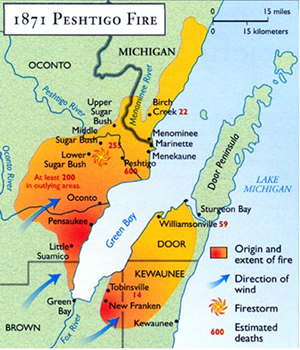
Where The Fires Burnt
Primitive firefighting techniques, plenty of fuel, wind, and fire ... no one will ever know how all the elements come together (one bizarre theory is that a comet going by Earth sets off both the Peshtigo, Chicago, and Michigan fires that start burning on the 8th), but sometime that day, several small fires combine into a holocaust of flame, heat, wind and smoke ... an uncontrollable Mother Nature firestorm monster consisting of a wall of fire over a mile tall and over five miles wide, traveling at 90 to 100 miles-per-hour, carrying heat hot enough to turn sand to glass (over 2,000 degrees Fahrenheit). A monster in need of victims!

Peshtigo - 1871
Smoke already in the air, at about 8:30 in the evening, the roaring sound of the approaching fire can be heard throughout the town, and citizens rush forward with water buckets to fight the flames ... a futile task that soon turns from fight to flight as the locals search for an escape ... and the deaths begin. Jumping into wells hoping the fire will pass over the wet, individuals are instead boiled to death by the heat, jumping into the river, people die from tornado whipped flaming fragments of the town falling on their heads and some succumb to hypothermia and drown in the autumn chilled waters of the river. For others death comes almost instantly when they inhale the superheated air and have their lungs scorched out of existence. At first, the bridge over the Peshtigo River seems a route to safety, but the fire is so huge it jumps the river and the far side becomes just another death trap ... as does the bridge, so many seek its faulty hope of safety that when combined with the flames licking at the structure, the span collapses into the river.
Fleeing Town
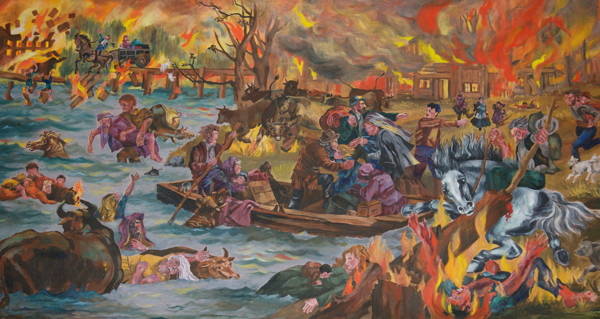
Trying To Cross The River
As one of the few survivors reports later in the local Peshtigo Eagle: “The frenzy of despair seized on all hearts, strong men bowed like reeds before the fiery blast, women and children, like frightened spectres flitting through the awful gloom, were swept like Autumn leaves. Crowds rushed for the bridge, but the bridge, like all else, was receiving its baptism of fire. Hundreds crowded into the river, cattle plunged in with them, and being huddled together in rise general confusion of the moment, many who, had taken to the water to avoid the flames were drowned. A great many were on the blazing bridge when it fell. The debris from the burning town was hurled over and on the heads of those who were in the water, killing many and maiming others so that they gave up in despair and sank to a watery grave.”
Peshtigo Fire Mural
Or this survivor account: “By now the air was literally on fire, scattering its agony throughout the town. Men, women, and children, clad in nightgowns and caps, shrieked with horror when they saw their loved ones burned alive. The entire town was a blazing inferno; there was only one escape; the river! Thousands of people… pressed on with terror in their eyes, going further into the river, where they remained the next day and night. Families were separated; little babies tried desperately to secure footing in the mucky river… yet the river wasn’t even safe, for swooping sparks and bits of fire dropped out of the sky burning entire bodies with an instant sweep!”
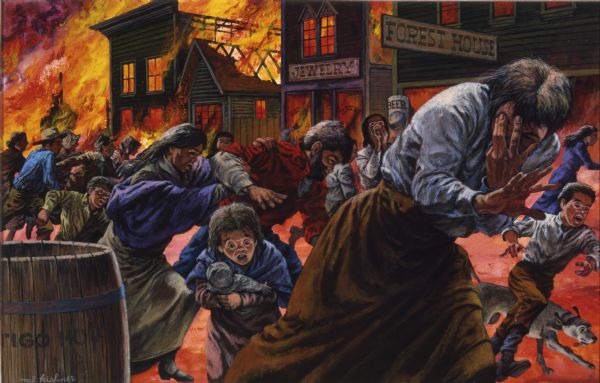
Peshtigo In Flames
Hell on Earth, and the town fares no better than most of its residents ... in a mere 90 minutes every structure in the town of Peshtigo is burnt to the ground, save one ... a newly built structure that's wood is too green to burn. Pretty much everything else is turned to ash (the only other exception are the walls of a brick kiln) ... including huge chunks of the surrounding region. Before rain falling the next day finally ends the holocaust, 1,875 square miles of forest is burnt down, an area twice the size of the state of Rhode Island (1,200,000 acres of land). And more communities are destroyed besides Peshtigo, twelve other smaller towns in all cease to exist ... no fixed casualty total is ever compiled and estimates of the toll vary from historian to historian, ranging from 1,500 souls up to 4,000 (only 250 will perish in the more well known Chicago Fire) deaths.
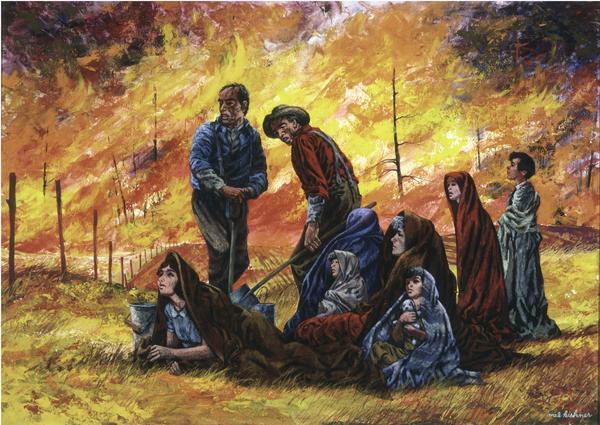
Trapped!

Fleeing Peshtigo
At the same time as the Peshtigo area is burning, another fire chars portions of the nearby Door Peninsula across the waters of Green Bay (making day into night from the clouds of smoke in the air, Samuel Drew, will keep the Green Island Light lit the whole day ... an effort which nonetheless fails to keep the three-masted schooner George L. Newman from going aground and wrecking). In the town of Robinsonville (now the community of Champion), farmers and local families flee to the town's Catholic church, where guided by Sister Adele Brise and other nuns, prays of salvation and devotions are sent off to the Virgin Mary ... who apparently is listening ... the church and its occupants are spared, while every other building in town is destroyed!
After - Wasteland And Dead Deer
The Green Island Lighthouse
Sister Brise
Eventually, aided by $150,000 raised with the help of the Wisconsin governor (birth of a rivalry, some supplies meant for fire damaged Chicago are instead routed to Green Bay, and then on to Peshtigo), the town of Peshtigo is rebuilt ... but the fire is never forgotten. A small town now of 3,000+, within the city limits are a mass grave at the Peshtigo Fire Cemetery containing 350 unidentifiable bodies that perished on 10/8, a memorial plaque on the new bridge over the river that commemorates the fire, and the Peshtigo Fire Museum (built on the site where the town's Catholic church burnt down), that includes the Church tabernacle that Father Peter Pernin saved by submerging it in the Peshtigo River (it survived unblemished), a small Bible partially burnt in the fire, a melted glass plate, and many first hand accounts from Wisconsin's most dreadful day!
Mass Grave

Mass Grave
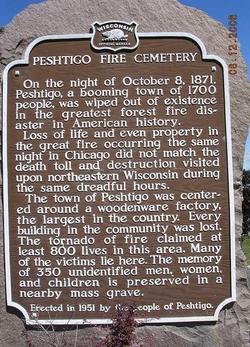
Historic Marker
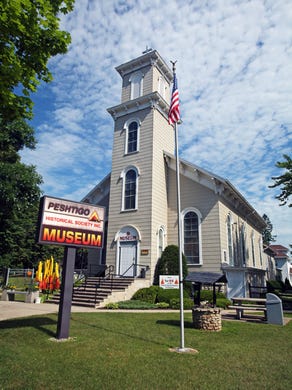
Peshtigo Fire Museum
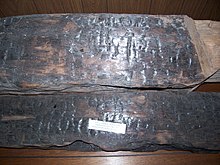
A Piece Of Wood That Survived The Inferno
10/8/1871 ... northern Wisconsin catches on fire (a conflagration so extreme that its elements are now called the Peshtigo Paradigm ... and a conflagration so extreme that it is studied as a model for Britain and the United States in their fire bombing of Germany and Japan during WWII) ... why today mattered!
Fire!
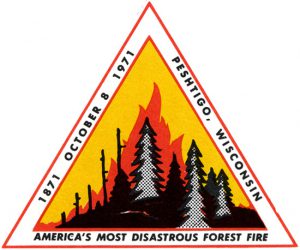
Centennial Seal designed by Peshtigo resident Wes Henry
No comments:
Post a Comment